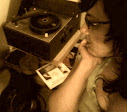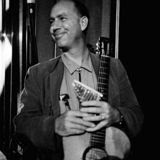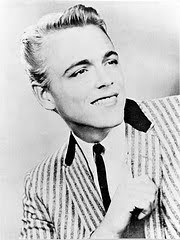
I'm currently conducting in-depth research for a scholarly/trade publication that I am co-authoring with Los Angeles-based PhD candidate Kirby Pringle, about country music behind bars in 20th century America. I know about some country music of course, but I never thought I'd know so much about the penal system in America! I mean, today NPR reported on the execution of a Texas inmate and I even remembered what the guy looked like from online research, and I knew who is next in line, what he looked like and when it will occur. It's amazing how much there is to know (whether or not I want to know it)!
My portion of the book will deal largely with Texas, while Kirby's will deal more with California. We'll both research other areas of course, but since we both reside in big "prison" states, that's just how things shake out. One of the main topics that I'm researching is the story of The Goree Girls.
A little known subject about a one-time insanely popular country/western swing/string band, at this time the only researched publication on the Goree Girls is an article written by Skip Hollandsworth; it was published in Texas Monthly in 2003. Other than that, I found a few blog entries here and there, but nothing substantial. Anyway, apparently Hollywood siezed upon the story a couple of years later and Jennifer Aniston's production company is making a movie about it RIGHT NOW...although who knows if it will ever actually be finished, as they've been "working" on it since 2007!
The Goree Girls were all inmates at the Goree State Farm for Women, which was the only female state penitentiary in the 1940s. As part of an ongoing campaign to improve the image of Texas' penal system, a radio show entitled "Thirty Minutes Behind the Walls" was devised and broadcast by Forth Worth-based radio station WBAP. It ran weekly from 1938 to 1944 and was a variety show of sorts. Musical numbers were played and sung entirely by inmates, comedy routines were performed and personal inmate interviews were conducted on air. Occasionally various other local legislators might come on as informative "guests" as well.
The primary performers were incarcerated at the men's penitentiary in Huntsville, and the nearby Goree State Farm for Women. The interesting thing about this show is that all races were featured - although not surprisingly, interviews were conducted with almost exclusively white inmates. You can totally tell by the way the announcer makes the introductions. Many folk songs of different heritages and languages were performed and popular songs of the time, along with hymns, were also frequently played...but I was surprised that not all were played and sung by the "obvious" choices. I wasn't there, of course, but it had to be perversely fascinating and eye-opening to the listening public, and it also provided a public platform for legislators to relay some subtle "messages" about the usefulness of their system.
A few weeks ago I was at the Dolph Briscoe Center for American History and found a bound transcript of the show. According to Hollandworth and other reseachers, no recordings of this show are extant (but we'll see). So the transcripts are all I have to work with...and upon reading them, all I have to say is, whoo-EEEE! Now I have to admit, my hackles are generally raised at the media's tendency to make utter hoopla about just any little ole thing, but I need to remember that there were days where the spread of propaganda was not only commonplace, but omnipresent and not even noticed (although Fox News viewers might still remain blissfully unaware). Ahh...who'm I kidding? It's just as omnipresent and little noticed today as it was then.
All in all, the tone of the show was almost disgustingly positive given the oppression that was really going on. For one thing, I seriously doubt the legislators ever discussed how they regularly performed eugenics on the prisoners, sterilizing female inmates upon incarceration so as to avoid the emergence of future 'reprobates.' And I doubt any inmate would talk about that during their on-air interview, if they ever again wanted to see the light of day. But you can rest assured that it DID happen, and to the very people I'm talking about.
The Goree Girls were not musicians so much as murderers (albeit due to crimes of passion or having grown up in extremely difficult circumstances). Nonetheless, eight of them formed a western swing band that performed on "Thirty Minutes Behind the Walls" beginning in 1940. It's still unclear to me whether this band was their own endeavor or "suggested" by the powers that be - I will need to research more into it to make a determination. I mean, they were all pretty young, cute, and personable so I'm thinking the latter just because of that fact, but it still needs to be proven. I've already gotten their convict numbers from the ledgers and soon I'll be looking up their conduct registers to see what I can see.
Whether the reasons for the creation of this band were exploitative or rehabilitative, the latter was the end result and the women were ultimately pardoned and released. But while they remained incarcerated, they learned to play instruments and harmonize - and their performances on the radio garnered them fans from all over, particularly the West coast - and even Hawaii (love me some short-wave radio)! Their thousands (upon THOUSANDS) of fans wrote letters and traveled for miles (upon MILES) to see them perform live. My research shows them having made a number of public appearances from the Texas Prison Rodeo to fairs to fiddling festivals, and I'm hoping to find out more about those and see if I can find even one wee recording or video of them performing.
At the same time, there are other stories to tell for this book. I recently was put in touch with an 86-year-old man who was a 3-time ex convict, serving two 3s and a fiver for running moonshine and distribution dealings with the mafia. He's also the father of a minor country music star in Nashville. I get to go make a visit to interview with him soon, and he's sharp as a tack and funny to boot and not shy about any of it. I saw a picture of him with his prison band - nothing like a bevy of young men in prison whites, cowboy hats, and steel guitars. Pretty cool!
I feel proud of this accomplishment for Kirby and myself since even Hollandsworth's interview with the last remaining Goree Girl didn't get to really discuss much firsthand; she was unfortunately senile and in fact died just weeks after the article was published. So I get to do with my interview with this other gentleman (and hopefully that's just a start), and I look forward to recording the Goree...whoops, I mean the gory details. I'm so happy to have an opportunity to document this small pocket of history- not just for the book, but for this man and his family.
Anyway...I just wanted to share this. I'm really excited about the work we're doing, and proposals for several University and independent publishers are in progress. Yee-haw!







